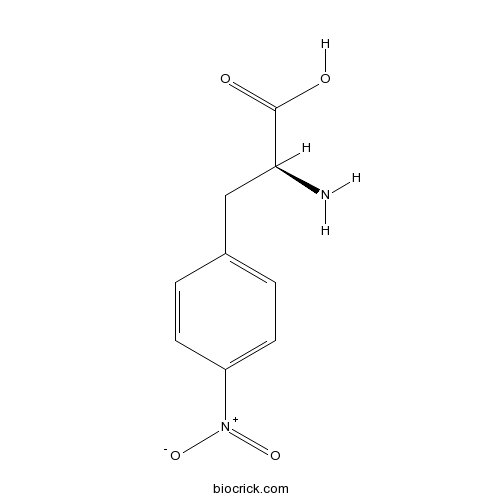H-Phe(4-NO2)-OHCAS# 949-99-5 |

- H-DL-Phe(4-NO2)-OH
Catalog No.:BCC3279
CAS No.:2922-40-9
- H-D-Phe(4-NO2)-OH
Catalog No.:BCC3274
CAS No.:56613-61-7
Quality Control & MSDS
3D structure
Package In Stock
Number of papers citing our products

| Cas No. | 949-99-5 | SDF | Download SDF |
| PubChem ID | 13706 | Appearance | Powder |
| Formula | C9H10N2O4 | M.Wt | 210.2 |
| Type of Compound | N/A | Storage | Desiccate at -20°C |
| Synonyms | 4-Nitro-L-phenylalanine | ||
| Solubility | Soluble in Chloroform,Dichloromethane,Ethyl Acetate,DMSO,Acetone,etc. | ||
| SMILES | C1=CC(=CC=C1CC(C(=O)O)N)[N+](=O)[O-] | ||
| Standard InChIKey | GTVVZTAFGPQSPC-QMMMGPOBSA-N | ||
| Standard InChI | InChI=1S/C9H10N2O4/c10-8(9(12)13)5-6-1-3-7(4-2-6)11(14)15/h1-4,8H,5,10H2,(H,12,13)/t8-/m0/s1 | ||
| General tips | For obtaining a higher solubility , please warm the tube at 37 ℃ and shake it in the ultrasonic bath for a while.Stock solution can be stored below -20℃ for several months. We recommend that you prepare and use the solution on the same day. However, if the test schedule requires, the stock solutions can be prepared in advance, and the stock solution must be sealed and stored below -20℃. In general, the stock solution can be kept for several months. Before use, we recommend that you leave the vial at room temperature for at least an hour before opening it. |
||
| About Packaging | 1. The packaging of the product may be reversed during transportation, cause the high purity compounds to adhere to the neck or cap of the vial.Take the vail out of its packaging and shake gently until the compounds fall to the bottom of the vial. 2. For liquid products, please centrifuge at 500xg to gather the liquid to the bottom of the vial. 3. Try to avoid loss or contamination during the experiment. |
||
| Shipping Condition | Packaging according to customer requirements(5mg, 10mg, 20mg and more). Ship via FedEx, DHL, UPS, EMS or other couriers with RT, or blue ice upon request. | ||

H-Phe(4-NO2)-OH Dilution Calculator

H-Phe(4-NO2)-OH Molarity Calculator
| 1 mg | 5 mg | 10 mg | 20 mg | 25 mg | |
| 1 mM | 4.7574 mL | 23.7869 mL | 47.5737 mL | 95.1475 mL | 118.9343 mL |
| 5 mM | 0.9515 mL | 4.7574 mL | 9.5147 mL | 19.0295 mL | 23.7869 mL |
| 10 mM | 0.4757 mL | 2.3787 mL | 4.7574 mL | 9.5147 mL | 11.8934 mL |
| 50 mM | 0.0951 mL | 0.4757 mL | 0.9515 mL | 1.9029 mL | 2.3787 mL |
| 100 mM | 0.0476 mL | 0.2379 mL | 0.4757 mL | 0.9515 mL | 1.1893 mL |
| * Note: If you are in the process of experiment, it's necessary to make the dilution ratios of the samples. The dilution data above is only for reference. Normally, it's can get a better solubility within lower of Concentrations. | |||||

Calcutta University

University of Minnesota

University of Maryland School of Medicine

University of Illinois at Chicago

The Ohio State University

University of Zurich

Harvard University

Colorado State University

Auburn University

Yale University

Worcester Polytechnic Institute

Washington State University

Stanford University

University of Leipzig

Universidade da Beira Interior

The Institute of Cancer Research

Heidelberg University

University of Amsterdam

University of Auckland

TsingHua University

The University of Michigan

Miami University

DRURY University

Jilin University

Fudan University

Wuhan University

Sun Yat-sen University

Universite de Paris

Deemed University

Auckland University

The University of Tokyo

Korea University
H-Phe(4-NO2)-OH
- Z-Gly-NH2
Catalog No.:BCC2769
CAS No.:949-90-6
- 2beta-(Isobutyryloxy)florilenalin
Catalog No.:BCN7976
CAS No.:94898-78-9
- Acuminatanol
Catalog No.:BCN6866
CAS No.:948884-38-6
- Tie2 kinase inhibitor
Catalog No.:BCC2561
CAS No.:948557-43-5
- Isolicoflavonol
Catalog No.:BCN4554
CAS No.:94805-83-1
- Glycycoumarin
Catalog No.:BCN7685
CAS No.:94805-82-0
- 20(R)-Notoginsenoside R2
Catalog No.:BCN3864
CAS No.:948046-15-9
- Bruceine J
Catalog No.:BCN8001
CAS No.:948038-38-8
- Bruceantinol A
Catalog No.:BCN8003
CAS No.:948038-36-6
- 3-pyr-Cytisine
Catalog No.:BCC6118
CAS No.:948027-43-8
- ML365
Catalog No.:BCC8063
CAS No.:947914-18-3
- HBTU
Catalog No.:BCC2814
CAS No.:94790-37-1
- Sodium formononetin-3'-sulfonate
Catalog No.:BCC1960
CAS No.:949021-68-5
- 6-(4-Hydroxy-3-methylphenyl)-2-methylhept-2-en-4-one
Catalog No.:BCN7514
CAS No.:949081-05-4
- 8-Hydroxy-ar-turmerone
Catalog No.:BCN7513
CAS No.:949081-09-8
- 6-Methoxynaringenin
Catalog No.:BCN4500
CAS No.:94942-49-1
- Gypenoside XLIX
Catalog No.:BCN1207
CAS No.:94987-08-3
- Quercetin-3-o-rutinose
Catalog No.:BCN3404
CAS No.:949926-49-2
- Thianaphthene
Catalog No.:BCC9178
CAS No.:95-15-8
- 5-Amino-1,3-dihydro-2H-benzimidazol-2-one
Catalog No.:BCC8728
CAS No.:95-23-8
- 2-Amino-6-chlorobenzothiazole
Catalog No.:BCC8539
CAS No.:95-24-9
- Chlorzoxazone
Catalog No.:BCC4650
CAS No.:95-25-0
- 2-Benzothiazolyl diethyldithiocarbamate
Catalog No.:BCC8558
CAS No.:95-30-7
- 2-(Morpholinodithio)benzothiazole
Catalog No.:BCC8484
CAS No.:95-32-9
Plant peptide hormone phytosulfokine (PSK-alpha): synthesis of new analogues and their biological evaluation.[Pubmed:15298181]
J Pept Sci. 2004 Jul;10(7):462-9.
Phytosulfokine-alpha (PSK-alpha), a sulfated growth factor (H-Tyr(SO3H)-Ile-Tyr(SO3H)-Thr-Gln-OH) universally found in both monocotyledons and dicotyledons, strongly promotes proliferation of plant cells in culture. In our studies on structure/activity relationship in PSK-alpha the synthesis of a series of analogues was performed: [H-D-Tyr(SO3H)1]- (9), [H-Phe(4-SO3H)1]- (10), [H-D-Phe(4-SO3H)1]- (11), [H-Phg(4-SO3H)1]- (12), [H-D-Phg(4-SO3H)1]- (13), H-Phe(4-NHSO2CH3)1]- (14), [H-D-Phe(4-NHSO2CH3)1]- (15), [H-Phe(4-NO2)1]- (16), [H-D-Phe(4-NO2)1]- (17), [H-Phg(4-NO2)1]- (18), [H-D-Phg(4-NO2)1]- (19), [H-Hph(4-NO2)1]- (20), [H-Phg(4-OSO3H)1]- (21), [Phe(4-NO2)3]- (22), [Phg(4-NO2)3]- (23), [Hph(4-NO2)3]- (24), [H-Phe(4-SO3H)1, Phe(4-SO3H)3]- (25) [H-Phe(4-NO2)1, Phe(4-NO2)3]- (26), [H-Phg(4-NO2)1, Phg(4-NO2)3]- (27), [H-Hph(4-NO2)1, Hph(4-NO2)3]- (28) and [Val3]- PSK-alpha (29). For modification of the PSK-alpha peptide chain the novel amino acids and their derivatives were synthesized, such as: H-L-Phg(4-SO3H)-OH (1), H-D-Phg(4-SO3H)-OH (2), Fmoc-Phg(4-SO3H)-OH (3), Fmoc-D-Phg(4-SO3H)-OH (4), Boc-Phg(4-NHSO2CH3)-OH (5), Boc-D-Phg(4-NHSO2CH3)-OH (6) Boc-Phe(4-NHSO2CH3)-OH (7), and Boc-D-Phe(4-NHSO2CH3)-OH (8). Peptides were synthesized by a solid phase method according to the Fmoc procedure on a Wang-resin. Free peptides were released from the resin by 95% TFA in the presence of EDT. All peptides were tested by competitive binding assay to the carrot membrane using 3H-labelled PSK according to the Matsubayashi et al. test.


